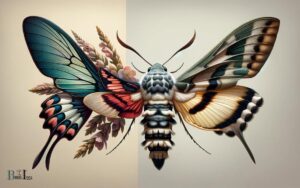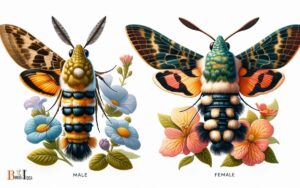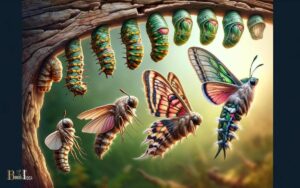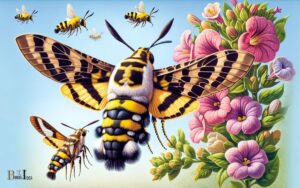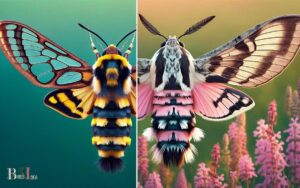Hummingbird Moth Vs Sphinx Moth: Discover the Differences!
Hummingbird moths and Sphinx moths are two distinct species known for their bird-like flight patterns.
While they share some behaviors, they can be differentiated by their appearance, lifecycle, and feeding habits.
Hummingbird moths are known for their clear wings and tail resembling feathers, whereas Sphinx moths, also known as Hawk moths, typically have more robust bodies and opaque wings.
The confusion between Hummingbird moths and Sphinx moths arises due to their similar flight characteristics. Both can hover in place and move swiftly, much like hummingbirds.
Here are some key differences:
Discover the unique traits that distinguish the agile Hummingbird moth from the robust Sphinx moth in nature’s diverse tapestry.
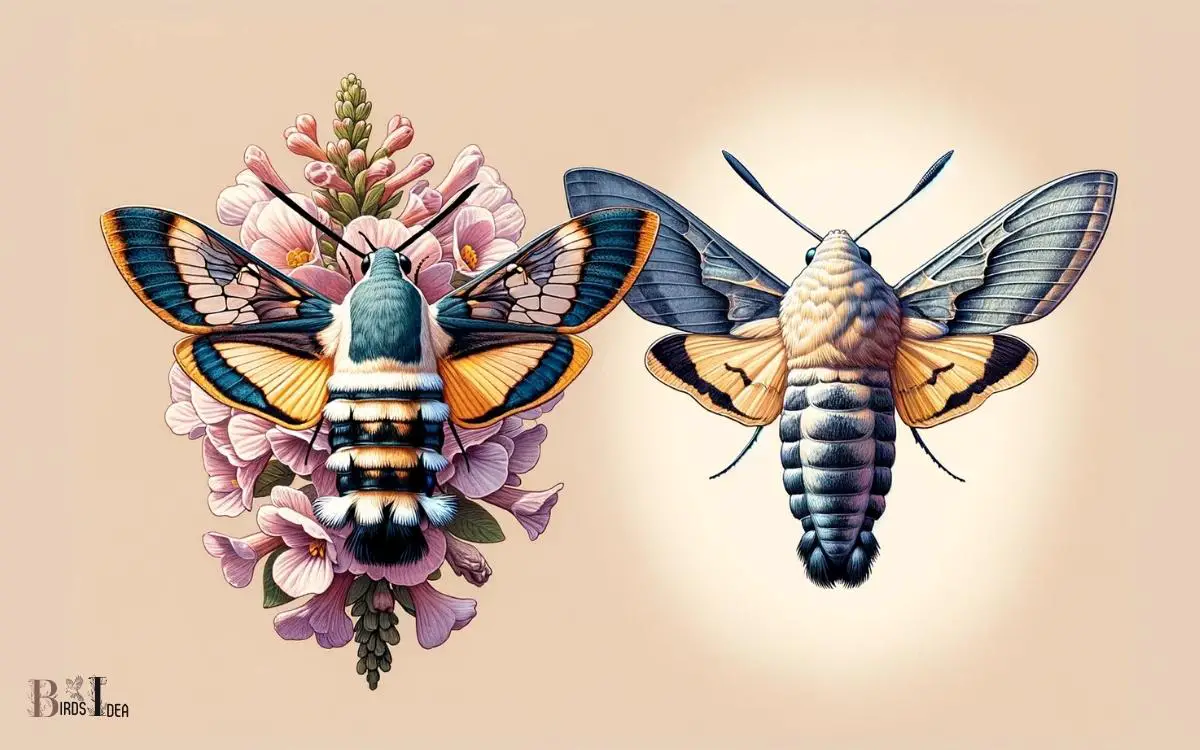
Key Takeaway
7 Common Features Comparison between Hummingbird Moths and Sphinx Moths
| Feature | Hummingbird Moth | Sphinx Moth |
|---|---|---|
| Size | Smaller compared to Sphinx moths | Larger body size |
| Wings | Clear or transparent with a feathery appearance | Opaque, often with distinct patterns or colors |
| Flight Time | Typically active during daylight hours | Usually active at dusk or during the nighttime |
| Proboscis Length | Long and flexible, similar to that of hummingbirds | Variable length, often long to access deep flowers |
| Antennae | Feathery or comb-like | Often stout and pointed |
| Caterpillar Appearance | Green with horn-like projections; less robust | Typically larger with horn at rear; robust |
| Habitat | Gardens, meadows, and woodland edges | Wide range, including gardens, forests, and meadows |
Physical Characteristics
The hummingbird moth and sphinx moth differ in their physical characteristics, such as size and wing pattern.
The hummingbird moth, with its sleek body, typically ranges from 1 to 2 inches in length. It has a reddish-brown abdomen and transparent wings with reddish-brown veins.
In contrast, the sphinx moth is larger, often reaching 2 to 3 inches in length. It has a bulkier body and broader wings, often with intricate patterns and vibrant colors.
These differences in size and wing pattern make it relatively easy to distinguish between the two moths when observed in their natural habitats.
Understanding these physical variances can contribute to a deeper appreciation of the diverse and fascinating world of moths.
Habitat and Distribution
The Hummingbird Moth is primarily found in North America. It is known for its ability to hover in mid-air, similar to a hummingbird.
The Sphinx Moth, on the other hand, boasts a global distribution. It can be found in various parts of the world, including North America, Europe, Asia, and Africa.
Both moths have adapted to a wide range of habitats, from forests and meadows to urban gardens.
This adaptability and resilience of these insects is fascinating and highlights their ability to survive in different ecosystems.
Understanding their habitat and distribution can provide valuable insights into their behavior and interactions with their surroundings.
Hummingbird Moth: North America
In North America, hummingbird moths can be found in a variety of habitats, including gardens, meadows, and woodland edges.
These adaptable creatures are known to thrive in both rural and urban areas, making them a common sight for many North American residents.
They’re prevalent across the continent, from the southern regions of the United States to the northern parts of Canada. Their ability to inhabit diverse environments has contributed to their widespread distribution.
Hummingbird moths are particularly attracted to nectar-producing plants, which are abundant in the diverse landscapes of North America.
Their presence in such varied habitats makes them accessible to a wide range of people, allowing for an appreciation of their unique characteristics and behaviors throughout the continent.
Sphinx Moth: Global Distribution
A large number of Sphinx moths can be found in various habitats across the globe, demonstrating their adaptability and widespread distribution.
- Habitats: Sphinx moths inhabit diverse environments including forests, grasslands, deserts, and even urban areas, showcasing their ability to thrive in different ecosystems.
- Global Distribution: They’re found on every continent except Antarctica, with the greatest diversity in tropical regions, indicating their ability to adapt to a wide range of climates and conditions.
Sphinx moths have proven to be highly adaptable and resilient, allowing them to establish a global presence.
This ability to thrive in various habitats has contributed to their significance in ecosystems worldwide.
Habitat: Varied Ecosystems
Thriving in diverse ecosystems across the globe, sphinx moths demonstrate remarkable adaptability and resilience.
These moths can be found in a wide range of habitats, including deserts, forests, meadows, and even urban environments.
Their ability to thrive in varied ecosystems is due to their flexible feeding habits and their capacity to utilize different host plants for breeding.
Sphinx moths are well-distributed throughout North and South America, Africa, and parts of Asia, reflecting their ability to inhabit a wide range of climates and geographic regions.
This adaptability allows them to coexist with other species and play essential roles in their respective ecosystems.
Understanding the sphinx moth’s habitat and distribution is crucial to comprehending its life cycle and behavior, which will be discussed in the following section.
Life Cycle and Behavior
Sphinx moths regularly undergo complete metamorphosis from egg to adult, displaying remarkable nocturnal behavior.
Life Cycle
- Eggs are laid on host plants, and larvae (caterpillars) feed voraciously, molting several times before pupating.
- Adults emerge from pupae, typically flying at dusk and through the night to feed and mate.
Behavior
- Sphinx moths use their long proboscis to feed on nectar from deep-throated flowers, often hovering like hummingbirds.
- They’re important pollinators, especially for night-blooming plants.
Sphinx moths’ fascinating life cycle and nocturnal behavior contribute to their significance in ecosystems.
This behavior also influences their feeding preferences, which will be explored in the subsequent section.
Feeding Preferences
Both the hummingbird moth and sphinx moth have distinct feeding preferences that set them apart.
While the hummingbird moth primarily feeds on nectar from a variety of flowers, the sphinx moth exhibits a preference for fruit juices and sap.
Additionally, the specific types of flowers or fruits that attract each species vary, contributing to their unique feeding behaviors.
Nectar Vs. Fruit Preference
The Hummingbird Moth and Sphinx Moth differ in their feeding preferences, with the former favoring nectar and the latter favoring fruits.
Nectar Preferences
- Hummingbird Moths have long proboscises that allow them to feed on nectar from deep flowers.
- They’re attracted to tubular, fragrant flowers, such as honeysuckle and phlox.
Fruit Preferences
- Sphinx Moths are known for their preference for ripe fruits, especially those with a strong aroma.
- They’re attracted to fruits like overripe berries and rotting fruits.
Understanding the nectar preference of the Hummingbird Moth and the fruit preference of the Sphinx Moth provides insight into their foraging behaviors and ecological roles.
Preferred Flower Types
One of the main defining characteristics of the Hummingbird Moth and Sphinx Moth is their preference for specific types of flowers when feeding.
Hummingbird Moths are commonly attracted to tubular-shaped flowers such as honeysuckle, bee balm, and trumpet vine. These flowers allow the moth’s long proboscis to reach deep into the flower to access nectar.
On the other hand, Sphinx Moths are more inclined towards flowers with a strong, sweet fragrance, such as petunias, moonflowers, and jasmine. These moths are also known to be drawn to white or pale-colored flowers.
Understanding these feeding preferences can help gardeners and nature enthusiasts attract these fascinating creatures to their outdoor spaces by planting the flowers that best cater to their needs.
Predators and Defense Mechanisms
Predators pose a constant threat to both the hummingbird moth and the sphinx moth, prompting the development of diverse defense mechanisms.
These moths have evolved various strategies to evade predators, ensuring their survival in the face of constant danger.
The following defense mechanisms are used by these moths:
- Camouflage: Both the hummingbird moth and the sphinx moth have developed remarkable camouflage, allowing them to blend seamlessly into their surroundings and avoid detection by predators.
- Mimicry: These moths also employ mimicry, resembling other animals or objects to deter predators and confuse them.
These defense mechanisms have proven essential in the survival of these moths in the wild.
Now, let’s delve into how these moths interact with plants.
Interactions With Plants
Interacting with plants, both the hummingbird moth and the sphinx moth play crucial roles in pollination and contribute to the ecosystem’s biodiversity.
As they feed on nectar from flowers, these moths inadvertently transfer pollen from one flower to another, aiding in the reproduction of various plant species.
This interaction is essential for the plants’ reproductive success and genetic diversity. The long proboscis of both moths allows them to access nectar from deep floral tubes, reaching nectar sources that other pollinators may not reach.
In return, the plants provide these moths with a vital food source, enabling them to sustain their energy levels for flight and reproduction.
This mutualistic relationship between the moths and plants showcases the interconnectedness and interdependence of species within the natural world.
Nessus Sphinx Moth vs Hummingbird Moth
The names “Nessus Sphinx Moth” and “Hummingbird Moth” are often used interchangeably for moths that share similar characteristics and behaviors. However, it’s important to note that there are multiple species within each group.
Nessus Sphinx Moth:
- Scientific Name: Sphinx nessus
- The Nessus Sphinx Moth is a type of sphinx moth that typically has a wingspan of 2.5 to 3 inches. It has a distinctive pattern on its wings, often featuring shades of brown, gray, and white. The body is robust, and the abdomen may have bands of contrasting colors.
Hummingbird Moth:
- The term “Hummingbird Moth” is a colloquial name that can refer to various species of moths that exhibit hummingbird-like behavior, including hovering in front of flowers and feeding on nectar.
- Two common species often referred to as Hummingbird Moths are the White-lined Sphinx Moth (Hyles lineata) and the Hummingbird Hawk-Moth (Macroglossum stellatarum).
White-lined Sphinx Moth (Hyles lineata):
- This moth is often mistaken for a small hummingbird due to its rapid and hovering flight. It has a wingspan of about 2.5 to 3.5 inches and is characterized by white stripes on its wings.
Hummingbird Hawk-Moth (Macroglossum stellatarum):
With a wingspan of around 1.2 to 2 inches, this moth is known for its rapid wing beats and hovering behavior, resembling a hummingbird. It has a brown and olive coloration with some species featuring clear wings.
In summary, while the Nessus Sphinx Moth is a specific species within the sphinx moth group, the term “Hummingbird Moth” is a more general descriptor that can be applied to various moths, including the White-lined Sphinx Moth and the Hummingbird Hawk-Moth, which exhibit behavior reminiscent of hummingbirds.
What are the main differences between a Bumblebee Moth and a Hummingbird Moth?
The main differences between a bumblebee moth vs hummingbird moth lie in their physical appearances. Bumblebee moths have yellow and black striped bodies, resembling bumblebees, while hummingbird moths have more of a slender, brownish body. Their flight patterns also differ, with bumblebee moths hovering and hummingbird moths darting.
Hummingbird Hawk Moth vs Hummingbird
The Hummingbird Hawk-Moth (Macroglossum stellatarum) is a fascinating insect that is often mistaken for a hummingbird due to its similar appearance and behavior.
Here are some key differences between the Hummingbird Hawk-Moth and an actual hummingbird:
Species:
- Hummingbird Hawk-Moth: It is a moth, not a bird, belonging to the sphinx moth family.
- Hummingbird: It is a bird, belonging to the avian family Trochilidae.
Body Structure:
- Hummingbird Hawk-Moth: It has a moth-like body with relatively small size, antennae, and compound eyes. Its wings are typically clear and may have a rapid, fluttering flight pattern.
- Hummingbird: It has a bird-like structure with feathers, beak, and eyes. It has strong and large wings, allowing it to hover in front of flowers.
Feeding Mechanism:
- Hummingbird Hawk-Moth: It feeds on nectar using a long proboscis, which it extends to reach the nectar of flowers. The proboscis is a coiled tube that resembles a straw.
- Hummingbird: It feeds on nectar using its long, specialized bill and extends its tongue into flowers to reach the nectar. A hummingbird’s tongue is a tubular structure.
Flight Pattern:
- Hummingbird Hawk-Moth: It hovers in front of flowers, resembling the hovering behavior of hummingbirds. It can also fly forward and backward.
- Hummingbird: It is capable of hovering in front of flowers due to its rapid wing beats, and it can also fly in various directions.
Time of Activity:
- Hummingbird Hawk-Moth: It is primarily active during the daytime, especially during sunny conditions.
- Hummingbird: Most hummingbirds are diurnal, being active during the day.
In summary, while the Hummingbird Hawk-Moth shares some remarkable similarities with hummingbirds in terms of appearance and behavior.
It is essential to recognize that they belong to different biological groups, with the Hummingbird Hawk-Moth being an insect (moth) and hummingbirds being birds.
Conclusion
Both the hummingbird moth and the sphinx moth are impressive creatures, but let’s be real, they’re basically just flying caterpillars with a flair for the dramatic.
Their physical characteristics and behaviors may seem majestic, but at the end of the day, they’re just bugs trying to survive in a world full of predators and plants that couldn’t care less about their existence.
Keep flapping those tiny wings, little moths, maybe one day you’ll reach butterfly status.

